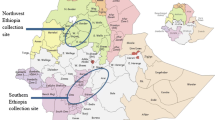Abstract
Ninety four accessions of the cultivated triploid potatoS. chaucha were analyzed and classified in genotypic groups using 9 isozyme loci and RAPD markers disclosed by 20 arbitrary 10-mer primers. Eight isozyme loci out of nine were polymorphic. A total of 22 allozymes were analyzed but none of them were specific for any genotypic group. About half (52%) of the 102 RAPD markers scored, were polymorphic, all of them showing polymorphism among groups and rarely within groups. Eighteen RAPD markers were specific for certain genotypes. The isozyme markers showed a certain amount of intra group variation which made classification less reliable than with RAPD markers. A total of 10 triploid genetic groups were discriminated using both techniques together. A single primer was found to be sufficient to distinguish all 10 groups. All varieties of a single group are considered to have been derived from the same cross and then clonally propagated, even though there is a high amount of morphological variation within a single genotypic group due probably to somatic mutations. RAPD markers have been shown to be more reliable in the classification of triploid potato varieties than other genetic markers like isozymes, proteins and morphological traits.
Similar content being viewed by others
References
Bassiri, A., 1976. Barley cultivar identification by use of isozyme electrophoretic patterns. Can. J. Plant Sci. 56: 1–6.
Buehler, R.E., M.B. McDonald, TTV, J. Tori & S.K.S. Martin, 1989. Soybean cultivar identification using high performance liquid chromatography of seed proteins. Crop Sci. 29: 32–37.
Bukasov, S.M., 1939. El origen de las species de papa. Rev. Arg. de Agronomía, 6: 230–236.
Douches, D.S. & C.F. Quiros, 1987. Use of 4χ − 2χ crosses to determine gene-centromere map distances of isozyme loci inSolanum species. Genome 29: 519–527.
Hawkes, J.G., 1963. A revision of the tuber bearing Solanums (2nd Ed.) Scot. PI. Breed. St. Annual Report, 76–181.
Hawkes, J.G., 1990. The potato. Evolution, Biodiversity and Genetic Resources. Belhaven Press, London.
Hu, J. & C.F. Quiros, 1991. Identification of broccoli and cauliflowers cultivars with RAPD markers. Plant Cell Rep. 10: 505–511.
Jackson, M.T., J.G. Hawkes & P.R. Rowe, 1977. The nature ofSolanum xchaucha Juz et Buk., a triploid cultivated potato of the South American Andes. Euphytica 26: 775–783.
Martinez-Zapater, J.M. & J.L. Oliver, 1984. Genetic analysis of isozyme loci in tetraploid potatoes (Solanum tuberosum L). Genetics 108: 669–679.
Ochoa, C., 1975. Las papas cultivadas triploides deSolanum xchaucha y su distribución geográfica en et Perú. Anales Cientificos UNA 13: 31–44.
Ochoa, C., 1990. The potatoes of South America: Bolivia. Cambridge University Press, Cambridge.
Quiros, C.F. & N. McHale, 1985. Genetic analysis of isozyme variants in diploid and tetraploid potatoes. Genetics 111: 131–145.
Quiros, C.F., M. Herrera, P. Cisneros & R. Ortega, 1990. Cosegregation of morphological tuber traits and isozymes in diploid potatoes. 75th Annual Meeting The Potato Association of America, Quebec, Canada, July 22–26.
Quiros, C.F., R. Ortega, L van Raamsdonk, M. Herrera-Montoya, P. Cisneros, E. Schmidt & S.B. Brush, 1992. Increase of potato genetic resources in their center of diversity: the role of natural outcrossing and selection by the Andean farmer. Genet. Resources and Crop Evolution 39: 107–113.
Quiros, C.F., A. Ceada, A. Georgescu & J. Hu, 1993. Use of RAPD markers in potato genetis: segregation in diploid and tetraploid families. Amer. Pot. J. 70: 35–42.
Shields, C.R., T.J. Orton & C.W. Stuber, 1983. An outline of general resource needs an procedures for the electrophoretic separation of active enzymes from plant tissue. In Isozymes in plant genetics and breeding. Part A. Edited by S.D. Tanksley and T.J. Orton. Elsevier Science Publishers B.V., Amsterdam. pp. 443–468.
Tanksley, S.D., 1984. Aconitase isozymes-new gene markers for tomato. Tomato Genet. Coop. Rep. 34: 16–17.
Tanksley, S.D., R. Bernatzky, N.L. Lapitan & J.P. Prince, 1988. Conservation of gene repertoire but not gene order in pepper and tomato. Proc. Natl. Acad. Sci. USA 85: 6419–6423.
Vallejos, C.E., 1983. Enzyme activity staining. In: S.D. Tanksley & T.J. Orton (Eds), Isozymes in plant genetics and breeding. Part A. Elsevier Science Publishers B.V, Amsterdam. pp. 469–516.
Vaughan, J.G. & K.E. Denford, 1968. An acrylamide gel electrophoretic study of the seed protein in ofBrassica andSinapis species, with special reference to their taxonomic nature. J. Exp. Bot. 19: 724–732.
Welsh, J. & M. McClelland, 1990. Fingerprinting genomes using PCR with arbitrary primers. Nucleic Acids Res 18: 7213–7218.
Williams, J.G.K., A. Kubelik, J.K. Levak, J.A. Rafalski & S.C. Tingey, 1990. DNA polymorphisms amplified by arbitrary primers are useful as genetic markers. Nucleic Acids Res. 18: 6531–6535.
Yang, X. & C.F. Quiros, 1993. Identification and classification of celery cultivars with RAPD markers. Theor. Appl. Genet. 86: 205–212.
Author information
Authors and Affiliations
Rights and permissions
About this article
Cite this article
Cisneros, P.L., Quiros, C.F. Variation and phylogeny of the triploid cultivated potatoSolanum chaucha Juz. et Buk. based on RAPD and isozyme markers. Genet Resour Crop Evol 42, 373–386 (1995). https://doi.org/10.1007/BF02432142
Received:
Accepted:
Issue Date:
DOI: https://doi.org/10.1007/BF02432142




